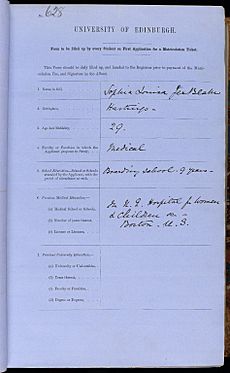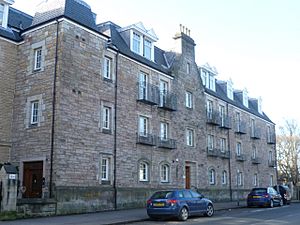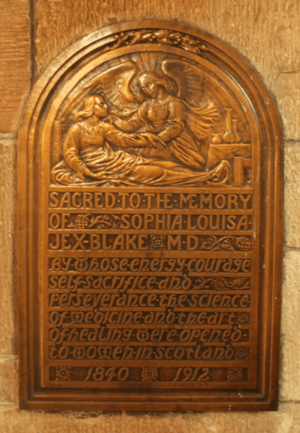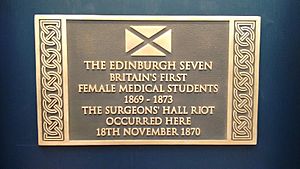Sophia Jex-Blake facts for kids
Quick facts for kids
Dr Sophia Jex-Blake
|
|
|---|---|
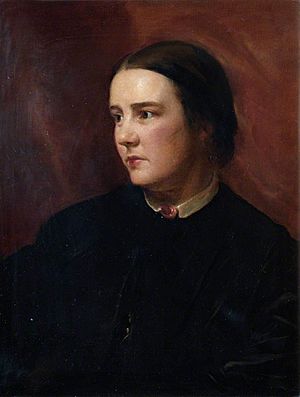
Portrait by Samuel Laurence 1865
|
|
| Born |
Sophia Louisa Jex-Blake
21 January 1840 |
| Died | 7 January 1912 (aged 71) Mark Cross, Rotherfield, Sussex, England
|
| Known for | campaigning for women's medical education member of the Edinburgh Seven |
| Medical career | |
| Profession | physician and teacher |
Sophia Louisa Jex-Blake (born January 21, 1840 – died January 7, 1912) was an English doctor, teacher, and a champion for women's rights. She led a big effort to help women get into universities. She and six other women, known as the Edinburgh Seven, started studying medicine at the University of Edinburgh in 1869.
Sophia was the first woman doctor to practice in Scotland. She was also one of the first in the wider United Kingdom of Great Britain and Ireland. She worked hard to open doors for women in medicine. She even helped start two medical schools just for women in London and Edinburgh. At that time, no other medical schools were training women.
Contents
Sophia's Early Life and Education
Sophia Jex-Blake was born in Hastings, England, on January 21, 1840. Her father, Thomas Jex-Blake, was a retired lawyer. Her mother was Mary Jex-Blake. Sophia was taught at home until she was eight years old.
Later, she went to different private schools. In 1858, she joined Queen's College, London, even though her parents didn't want her to. In 1859, she became a math tutor at the college. She worked without pay because her family didn't think she needed to earn money.
Discovering Her Dream to Be a Doctor
In 1865, Sophia traveled to the United States. She wanted to learn more about how women were educated there. She visited many schools and was impressed by how boys and girls studied together. She later wrote a book about her trip.
In Boston, she met Dr. Lucy Ellen Sewall, one of the first female doctors in the country. Sophia worked as an assistant at the New England Hospital for Women and Children. This experience changed her life. She realized that becoming a doctor was what she truly wanted to do.
In 1867, Sophia and another trainee, Susan Dimock, asked Harvard University if they could join its Medical School. A month later, they got a letter back. It said that the university had no way to educate women. The next year, Sophia planned to attend a new medical college in New York. But her father passed away, so she returned to England to be with her mother.
Fighting for Equal Chances in Medicine
In 1869, Sophia Jex-Blake wrote an essay called Medicine as a Profession for Women. It was part of a book edited by Josephine Butler. In her essay, Sophia argued that women naturally cared for the sick. However, girls were often only taught home skills. This meant women couldn't get the training to become doctors like men.
Sophia believed there was no proof that women were less smart than men. She said the best way to find out was to give women "a fair field and no favour." This meant teaching them the same way men were taught. They should also take the exact same exams.
The Fight for University Education for Women Begins
Sophia Jex-Blake was determined to get medical training in the UK. She thought Scotland might be more open to women studying. This was because Scotland already had more modern ideas about education.
In March 1869, she applied to study medicine at the University of Edinburgh. The medical teachers and the university leaders voted to let her study. But the University Court said no. They claimed the university couldn't make special arrangements "for one lady."
Sophia then put ads in newspapers like The Scotsman. She asked other women to join her. In the summer of 1869, a second application was sent. It was for five women at first, then two more joined later. This group became known as the Edinburgh Seven. The women were Mary Anderson, Emily Bovell, Matilda Chaplin, Helen Evans, Sophia Jex-Blake, Edith Pechey, and Isabel Thorne. They asked to be fully enrolled at the university. This meant they wanted to attend all classes and exams needed for a medical degree.
The University Court approved this second application. This made the University of Edinburgh the first British university to accept women. Sophia Jex-Blake wrote to her friend Lucy Sewall: "It is a grand thing to enter the very first British University ever opened to women, isn't it?"
Growing Problems and the Surgeons' Hall Riot
As the women showed they could do just as well as the male students, some people became angry. The women received rude letters and were followed home. People even put fireworks on their doors and threw mud at them.
Things got worse on November 18, 1870. This was the day of the Surgeons' Hall riot. The women arrived to take an anatomy exam. Outside, a large angry crowd of over two hundred people had gathered. They threw mud, trash, and insults at the women.
These events were reported in national newspapers. Many new people started to support the women. However, some powerful medical teachers convinced the university to stop the women from graduating. They took the decisions to higher courts. The courts eventually ruled that the women should never have been allowed to start the course. Their degrees were taken away, and the campaign in Edinburgh failed in 1873.
Many of the women went to universities in Europe. These universities already allowed women to graduate, so they finished their studies there.
The Time for Change Had Come
Women were finally allowed to join degree programs at other British universities in 1877. James Stansfeld, who supported the women's campaign, wrote about these events. He said:
"Dr Sophia Jex-Blake made the biggest contribution to this success. The main reason for success was simply that the time was right for change. When the time for a reform has come, you cannot stop it. If you try, you might even make it happen faster. Those who oppose change, when the time is right, actually help it along."
Becoming a Qualified Doctor
In 1874, Sophia Jex-Blake helped create the London School of Medicine for Women. She also kept fighting for women's rights and continued her studies. Soon after, the Medical Act of 1876 was passed. This new law allowed medical groups to give licenses to all qualified people, no matter their gender.
The first group to use this new law was the Royal College of Physicians of Ireland. But before Sophia applied there, she passed medical exams at the University of Berne. She earned her MD (Doctor of Medicine) degree in January 1877. Four months later, she had more success in Dublin. She qualified as a Licentiate of the King and Queen's College of Physicians of Ireland. This meant she could finally be registered with the General Medical Council. She was the third registered woman doctor in the country.
Sophia's Medical Career
Sophia Jex-Blake returned to Edinburgh. In June 1878, she opened her own practice at 4 Manor Place. Edinburgh now had its first woman doctor. Three months later, she opened a clinic for outpatients at 73 Grove Street. Poor women could get medical care there for a small fee.
After her mother died in 1881, Sophia had a difficult time. By 1885, her clinic grew and moved to a bigger building at 6 Grove Street. A small five-bed ward was added. This small clinic became the Edinburgh Hospital and Dispensary for Women. It was Scotland's first hospital for women, run entirely by women.
In 1886, she started the Edinburgh School of Medicine for Women. This was a small class, helped by a few male doctors from the University of Edinburgh. These doctors gave classes open to both men and women. The first students included Elsie Inglis and Grace Ross Cadell. However, Sophia was not as good at teaching as she was at being a doctor. She had a big disagreement with her students. This led to a famous court case in 1889, where Sophia had to pay damages.
After this, the Cadell sisters studied with Elsie Inglis. Elsie Inglis had started a different school, the Edinburgh College of Medicine for Women. Sophia's school mostly ended in 1892 when the University of Edinburgh started accepting female students.
Sophia lived and worked for 16 years at a house called Bruntsfield Lodge. When she retired in 1889, the Edinburgh Hospital and Dispensary for Women and Children moved to this site. It became known as Bruntsfield Hospital and stayed there until 1989.
Sophia's Personal Life
Sophia Jex-Blake is believed to have been in a close relationship with Dr. Margaret Todd. When Sophia retired in 1899, they moved to a place called Windydene in Mark Cross. There, Dr. Todd wrote two books.
Sophia's home became a place where her former students and friends would visit. She welcomed writers and people she knew from all over the world.
Death and Remembering Sophia
Sophia Jex-Blake died at Windydene on January 7, 1912. She is buried at St Wulfrans, Ovingdean. Dr. Todd later wrote a book about Sophia's life.
The University of Edinburgh has a plaque near its medical school to remember Sophia Jex-Blake. It honors her as a "Physician, pioneer of medical education for women in Britain, alumna of the University."
In 2015, a special plaque was put up to remember the Surgeons' Hall Riot of November 18, 1870.
On July 6, 2019, the Edinburgh Seven were given honorary medical degrees (MBChB) after their deaths. This happened at the University of Edinburgh’s McEwan Hall. A group of current students from the Edinburgh Medical School collected the degrees for them. Simran Piya, a medical student, collected the honorary degree for Sophia Jex-Blake. This graduation was the first of many events planned by the University of Edinburgh to celebrate the achievements of the Edinburgh Seven.
In 2020, a brewery named Bellfield Brewery created a new beer called Sophia Jex-Blake. In 2021, a play about Sophia Jex-Blake and the Edinburgh Seven, called "Sophia" by Scottish writer Frances Poet, was announced.
Images for kids
See also
 In Spanish: Sophia Jex-Blake para niños
In Spanish: Sophia Jex-Blake para niños



